Hello everyone, this is Leïla from Inkoo, and this week's topic is greenwashing in textiles and how to spot it. At Inkoo, we don't just talk about it — we also offer products that align with these commitments.
Key Takeaways
- How to spot greenwashing in textiles: the signs, buzzwords, and empty claims to look out for.
- Why “Made in France” doesn’t always mean ethical – and what truly matters instead.
- The difference between real labels and vague marketing – plus the ones you can trust (GOTS, FairWear, etc.).
- Why labour cost is the key to understanding real textile pricing – and how low-cost means high human cost.
- How INKOO keeps it real – with local production, certified textiles, and a commitment to transparency.
1. Introduction
A brief definition of greenwashing.
So, what is greenwashing in fashion, you may ask?
It is a mixture of many appealing elements, but overall it often involves deceptive marketing tactics that lead consumers to believe that a company has a great ecological image when this is not true.
The use of vague words such as “eco”, “sustainable” and “natural” is rife, without any certification or supporting evidence. Production is often opaque and conditions are unclear.
Why this is a real issue in the textile industry, even B2B.
It is well known that the textile sector is one of the most polluting in the world, with fashion responsible for around 10% of global CO₂ emissions (‘The fashion industry is responsible for up to 10% of global carbon emissions’ (UNEP, 2021).) and ranking among the top 5 carbon-emitting sectors.
Unfortunately, labels are often misunderstood or misused: some use partial or unrecognised certifications to give a false impression of sustainability.
‘Made in Europe’ can mean many things and generally hides a much less ethical reality: the garment may be made locally, but with imported materials that have a high impact or are produced in questionable working conditions. We will come back to the subject of “Made in France” a little later, which I find quite interesting.
Both B2B and B2C consumers are increasingly attentive to this kind of practice: reputation and brand image are therefore very important to them, and they will be able to tell if a company is opportunistic or inconsistent with its values.
Unfortunately, it is often the truly responsible brands that are penalised: in the face of greenwashing, committed players must redouble their efforts to differentiate themselves and justify their choices and prices.
But good news : laws are changing: certain regulations are beginning to regulate these practices, such as the European directive on environmental claims, which aims to ban unjustified ecological claims. (European Commission (2023). Directive on substantiation and communication of explicit environmental claims. Available here [Accessed 22 Jul. 2025].)
Now that I have given you all this information, you may be interested to know: What is brand image and why should you make yours sustainable?
2. Greenwashing in textiles: signs to look out for
Can we really talk about responsible production when a T-shirt is labelled “Made in France” but sewn from cotton sourced in India, dyed in Turkey and printed in Poland?
In the textile industry, “green” promises are multiplying. But behind the slogans, it's difficult to know what to believe. Here's how to spot genuine commitments... and attempts at textile greenwashing.
As I mentioned earlier, the first clue is the use of overly vague words such as “eco-friendly”, “green” and “sustainable” – without any concrete evidence. No real certification, sometimes invented or self-proclaimed.
Other clues may include promoting an “eco” product in a completely polluting range; marketing that focuses heavily on storytelling rather than evidence; abnormally low prices for supposedly ethical products (hello Temu, Shein and Alibaba).
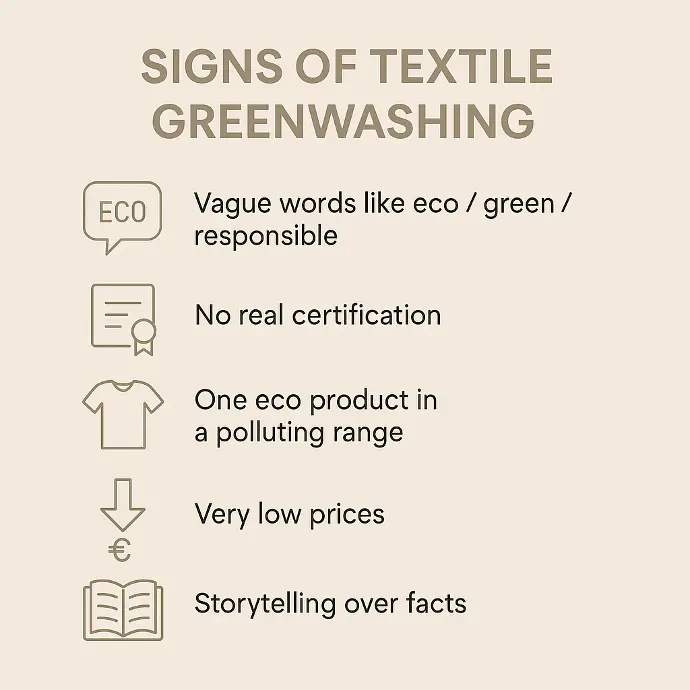
3. Made in France: not always synonymous with ethical production
The ‘Made in France’ textile label is well known, but do you really know what it covers?
Let's see – the law stipulates that at least 45% of its added value must have been produced on national soil – which isn't very fair when you consider the cost of labour in France compared to the cost of labour in India, for example.
Basically, you can import thousands of tote bags made in India at a lower cost, apply a little screen-printed ink in a workshop in France and quietly affix the ‘Made in France’ label.
Now, don't get me wrong, I'm not singling out France in particular (long live cheese!), but this is just to illustrate a very common example of what greenwashing can mean. If you want to know more about the subject of “made in France”, I found a great article here.
So “Made in France” does not necessarily mean local production. It means local processing of an imported product, and that changes everything in terms of impact.
But be careful, the origin of the raw materials matters a great deal. Is the cotton organic or not, is there traceability available? Was it manufactured in Asia or Europe? The place of finishing alone is not enough to assess the sustainability of a product.
Another point: transport has little impact on the overall textile footprint. According to ADEME, transport accounts for less than 10% of the environmental impact of a garment on average — the bulk of the impact occurs during the cultivation, processing and manufacturing stages.
Source: ADEME (2021) The environmental impact of jeans. [Online] Available here. [Accessed 22 July 2025].
So what really matters is transparency. At every stage: material, spinning, weaving, dyeing, manufacturing, printing. A good supplier will show you everything. A good label will too.
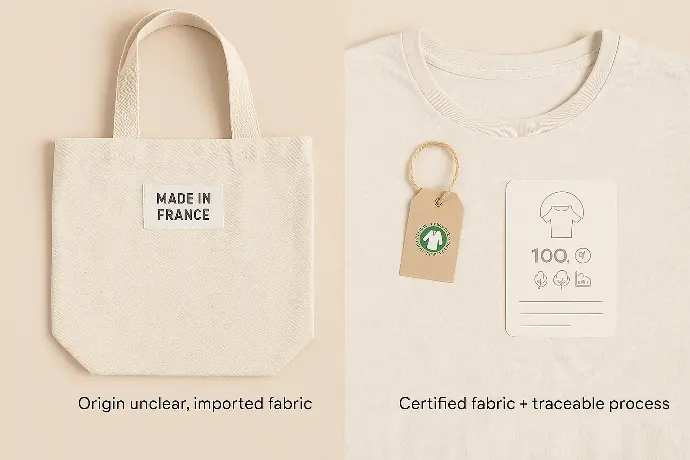
4. Labels vs. vague marketing: how to tell the difference
Today, displaying an ethical or ecological label on a textile has become a real selling point. But not all labels and certifications are created equal—and some are more about marketing than real commitment.
Here are some reliable certifications to look out for:
- GOTS - Global Organic Standard: guarantees organic fibres, but also social and environmental criteria throughout the production chain.
- Ecovadis : independently assesses companies' CSR (Corporate Social Responsibility) performance across four main pillars: environment, social & human rights, ethics, and responsible purchasing.
- Fair Wear Foundation: focuses on ethical working conditions in garment factories.
- PETA-Approved Vegan: ensures that no animal-derived components are used.
These labels are reliable because they are independent, verifiable and subject to regular audits.
But beware of vague and false certifications. Some brands like to invent their own internal certifications and use vague terms such as “eco-designed textiles”, “responsible cotton”, etc. These claims are not governed by any standards, prove nothing and offer no transparency across the entire production chain.
So I advise you to be wary of vague, unsourced claims and don't hesitate to ask for proof of the actual label or supplier certificate.
Take the OEKO-TEX® Standard 100 label, for example:
It guarantees that no harmful substances are present in the finished product.
But it is often misunderstood — many people read it as ‘eco-tex’ and associate it with a global ecological approach.
In reality, this label only concerns the chemical safety of the final product, not the working conditions or the environmental impact of production. Nor does it guarantee the absence of harmful substances during the manufacturing stages.
How can traceability be verified via labels?
A good label allows you to trace precisely:
- the origin of raw materials,
- the stages of processing
- the social and environmental commitments at each stage
These labels, needless to say, lend credibility to your ecological approach, reassure your customers and avoid any suspicion of greenwashing on your part.
At Inkoo, we work with select, exceptional suppliers who all have labels that guarantee ethical manufacturing.
5. Labour costs: the real crux of the matter
When it comes to textiles, labour costs are the biggest factor in the total cost of producing a finished garment. But this is often the variable that is least talked about in the marketing campaigns of major brands.
Why is this variable so important?
Producing a garment does not cost very much in terms of raw materials.
The most expensive aspects are the time spent making the garment, the wages paid to workers and seamstresses, and social conditions (working hours, trade union rights, safety, etc.).
So a t-shirt that costs 2€ when it leaves the factory is not magic: it is the result of very low wages and precarious working conditions in certain manufacturing countries.
But what is the correlation between cost, quality and working conditions? A very low price is rarely synonymous with high manufacturing quality (strong seams, neat finishes, etc.). Nor is it compatible with certified or organic raw materials, or even with an ethical working environment.
Conversely, paying a little more means financing audited factories, guaranteeing fundamental rights (decent wages, safety, etc.) and certainly being able to benefit from a more sustainable product.
The hidden side of low-cost production
Regions such as Southeast Asia, Africa and Central America are often chosen for their low-cost labour. But behind this offshoring lie wages below the poverty line, excessive working hours, and sometimes even forced or child labour.
The true cost of fast fashion is not what we pay at the checkout — it's what it costs elsewhere.
But what is the real price of an ethical t-shirt?
At Inkoo, our textiles are printed and embroidered in Belgium, on certified materials. This includes:
- fairly paid European labour,
- recognised labels (GOTS, FairWear, etc.),
- sustainable and traceable production.
Choosing an ethical textile means investing in quality, transparency and human respect.
6. What INKOO does to remain transparent
At INKOO, we don't claim to be perfect — but we do everything we can to remain transparent, consistent and ethical. Our approach is based on concrete choices:
Local production: all our printing is done in our workshop in Nivelles, Belgium. This allows us to guarantee quality control and limit intermediaries.
Certified textiles only: we work exclusively with certified products (GOTS, FairWear, etc.) to ensure that every project is ethical.
Environmentally friendly techniques: water-based screen printing, DTF, embroidery — each method is explained transparently, with its advantages and limitations. If you would like to find out more about our techniques, please visit: this page where I did my best to explain it.
After all, what is the point of choosing the right raw materials, sourced correctly, if we are going to use old plastisol inks that are just as likely to contaminate us?
A rejection of disposable items: we say no to single-use or short-lived projects. Our goal: textiles that last, are worn and appreciated.
Genuine customer focus: we engage with each brand to find the right balance between ambition, technical constraints and ethical consistency.
Inkoo is committed to sustainable textile production, with choices that align with our values — not just empty words.
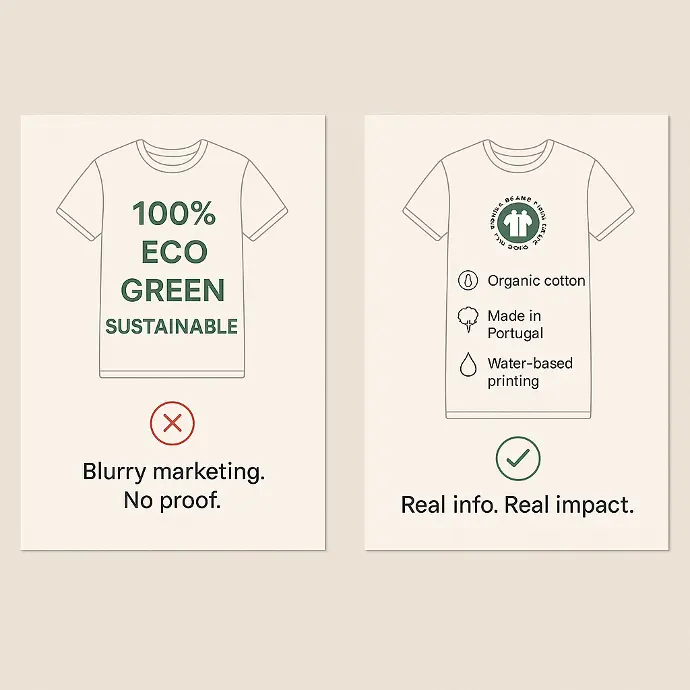
7. Conclusion
In a world where greenwashing blurs the lines, asking the right questions has become essential.
- What is the product's true journey?
- Where do the raw materials come from?
- Who made it, and under what conditions?
Textile transparency is not always visible at first glance — but it can be proven. At Inkoo, we prefer to show what we really do, rather than make vague promises. If you want to see what we do, we are very active on Instagram.
Whether you are a brand, an agency or a company, we are here to support you in making merchandising choices that are consistent, sustainable and aligned with your values.
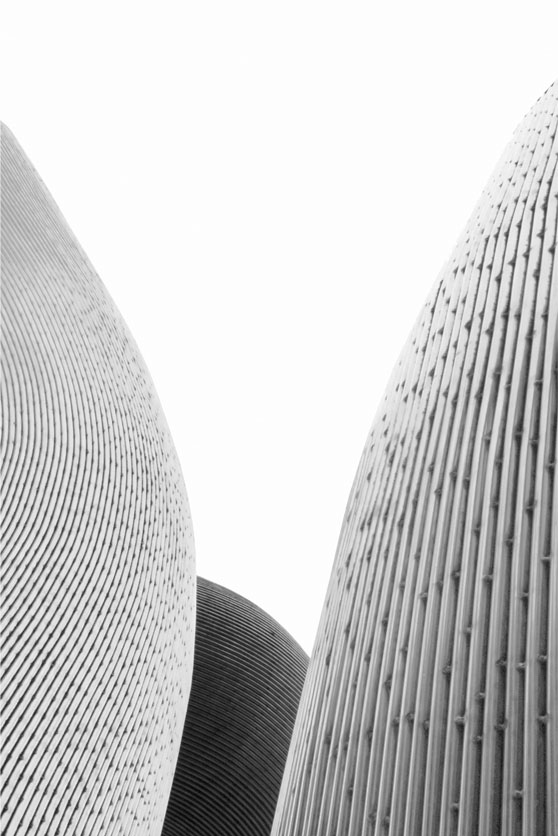
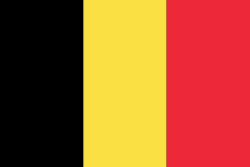
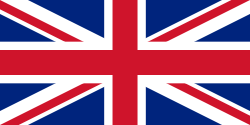
Greenwashing in textiles: signs to look out for